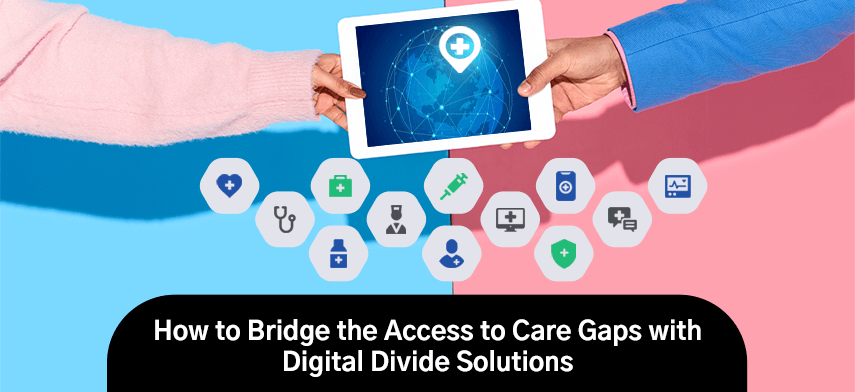The smooth and swift adoption of telehealth services during the pandemic brought into focus the concept of digital divide solutions into the limelight. In the healthcare sector, the access gaps in technology and the internet for the underserved populations were noticeable. As telemedicine visits are not limited to video or on-call communication, the conversation between patients and providers needs to expand beyond this technology and internet-based healthcare. Considering the digital divide solutions in healthcare, the lack of access to technology has been termed as SDOH or Social Determinants of Health and this has to expand our perspectives beyond the accessibility to gaps in care, innovations, and support to healthcare for the underserved individuals.

Communities belonging to the underserved regions do use technology, but digital health solutions are not particularly tailored for those belonging to the aging population with those amongst the lower digital literacy space. Amidst the COVID pandemic, which accelerated the new digital era in healthcare, integrating emerging technologies like telehealth services, IoT, and artificial intelligence continues to explore technology-enabled solutions, which can be a hindrance when focussing on access to health issues. According to a publication by Accenture, 93% of healthcare executives exclaimed that prioritizing innovations for their organizations in 2021, while 81% exclaimed a rapid pace in adopting the innovations for their organizations. This increase in innovations is being funded with an estimated USD 6.7 billion for digital health. This transformation in technology has been beneficial for both providers and patients. By 2026, more than 28% of the telehealth market is expected to reach new heights. Digital healthcare solutions especially telehealth services have made access to healthcare more cost-effective, convenient, and efficient. Telehealth services have reduced patient wait times, eliminated the need for people to take hours off work to communicate with providers, and decreased the risk of transmission of diseases. Even with this, gaps in access to care still exist and accessibility is still a main concern in the bridging digital divide.
Effects of Digital Divide in Telehealth Services for Underserved Communities
There are persistent disparities in certain communities with the same quality of internet access that is required for telehealth services. Certain states in the US also have disadvantages due to lack of internet access and the Health Professional Shortage Areas HPSAs lack adequate access to mental health, primary care, and dental care services and providers. Hence, creating a gap in access to healthcare services. Several populations have less literacy rates when it comes to accessing digital healthcare technology solutions, limiting their access to digital health tools, internet-enabled healthcare devices, and engaging in virtual care services. Hence, several vulnerable populations are limited from accessing telehealth services, even though they require this technological accessibility. These are the effects of digital divide in telehealth services faced by the rural and underserved communities.
Improving the Healthcare Gap for Health Equity and Telehealth Accessibility
Understanding the true potential of telehealth services and digital healthcare solutions is critical when focusing on innovations that are accessible to all. Without finding the correct digital divide solution and having a concrete infrastructure to make healthcare accessible, the segregation to care may not be diminished. The healthcare equity solutions and their accessibility impacts everyone involved in the process and ensures proper care benefits for all.
Creating an infrastructure that involves more telehealth and digital healthcare accessibility solutions can improve the ability of providers to address any lingering access to care gaps. This helps to bolster the effectiveness of outreach towards patients and lays a proper groundwork for having effective conversations with patients who are categorized under the vulnerable sector and need immediate treatment for their conditions. To improve the telehealth services’ accessibility and enhance health equity solutions for underserved communities, the focus is to find access to high-speed internet connectivity. Making 5G connectivity more accessible in rural and underserved areas can help patients to gain better healthcare services virtually.
Bridging Digital Divide Gaps to Care Access
The limelight is on the healthcare disparities already existing in the health infrastructure, we are leveraging different forms of telehealth services to ensure better and faster access to high-quality care for patients. Bridging the digital divide gaps in care access can help in several efforts by optimizing telehealth and remote patient monitoring services.
By improving community outreach through accessible resources
Telehealth services if focused mostly on video encounters can worsen the disparities in healthcare access if we don’t proceed with the necessary care plans. The lack of proper and reliable broadband connections can diminish the services of healthcare to patients. To effectively minimize this lack of accessibility, several interventions have been integrated to ensure better telehealth access to patients.Medicare coverage and healthcare policies
The large-scale and crucial efforts of telehealth services expanded the reimbursement and insurance coverage practices during the initial surge in the COVID-19 pandemic. The changes in reimbursement and regulation plans remain a temporary factor and are directly associated with the declaration of public health emergencies in the US. Moving beyond, the health advocacy will be applying efforts in ensuring patients have several options to connect with the providers and physicians. In 2021, the Medicare payment policy that surrounded telehealth services in bridging the digital divide in healthcare simplified and streamlined the billing process in telehealthcare. Medicare programs are enabling patient-initiated check-ins virtually. The addition of financial support in the healthcare sector can helo ti improve marketing and efforts toward patient outreach programs and clinicians can help to promote the benefits of their organization’s available services. Future R&D can quantify the number of telehealth calls and improve patient outcomes, in turn generating revenue.Improvement aimed at different avenues
The health equity solutions and the future of telehealth will require to be more proactive with intentional changes. Having helpful strategies in place can be of immense assistance to providers. The provision of kiosks and wi-fi hotspots can improve patient access to healthcare. With proper precautions and guidelines, the improvement aimed at different avenues to provide healthcare services can offer the underserved and rural communities the much-required means of primary and mental healthcare delivery services. Facilities are standardizing the technology instruction in providing digital divide solutions and improving the overall connectivity of schedules for providers and patients. We should be aiming at collaborating and innovating various ways to offer quality care management based on the unique requirements of communities and understanding their SDOH. While remote patient monitoring is still catching up to the established telehealth expansion, every available healthcare resource for patients needs to be addressed. With constant evaluation and reevaluation, rapid sharing of innovations and quality of care can help in bridging digital divide.
Countering the Technological Divide through Digital Divide Solutions
It is crucial when reaching an agreement on the governance of health data and standards of interoperability for sharing these data. Early successes have been noted with the development of FHIR for defining the standards of data exchange among various health systems.
Well-known tech companies are positioning themselves as their primacy for health data transference. WHO has been working towards establishing healthcare app development and approaching tech companies to improve and apply these standards of healthcare in the community of healthcare practices. This will help to improve the healthcare delivery solutions via telehealth services and empower greater deployment for the basis of a better accessible health system. As we recognize the technology divide in our communities, the digital disconnect has gained recognition and limelight during the pandemic, especially for the aging population assisting them to navigate through complicated digital systems to access vaccines, appointments, and tests bridging the gap in the technology divide.
Furthermore, the renewal of research and focus on policies catering to fraud detection and security in telehealth services need to be put in place. Providers and patients need to have a safe space for sharing sensitive healthcare information through virtual capabilities. Innovations in healthcare since the beginning of the pandemic have created brilliant criteria for making care more accessible, but the road is still a long way from the goal. With digital healthcare transformation remaining the top priority, we as business leaders and organizations should also focus on health equity solutions for better access for those who are in dire need of these innovations. Closing the digital divide depends on advancing with health equity solutions that are considered essential and will bear the necessary results.

To conclude,
To overcome this access to care services, digital divide solutions have been put in place for underserved and aging populations to take advantage of proper healthcare services via virtual standpoints. Digital healthcare companies are making their presence known by spreading the information and recognizing the flaws in the healthcare systems. With the pandemic exacerbating the access to proper and appropriate care delivery, telehealth services are moving towards creating an equal opportunity in providing a holistic care team model to those who require it. Even with the barriers to structural inequities, implementation of the correct strategies can help to ensure equitable virtual care delivery models and this will further help the healthcare sector to move forward and beyond.

Author's Bio

Dr. Kedar has more than 12 years of experience in the healthcare domain. She advises Mobisoft Infotech in healthcare-related matters.


